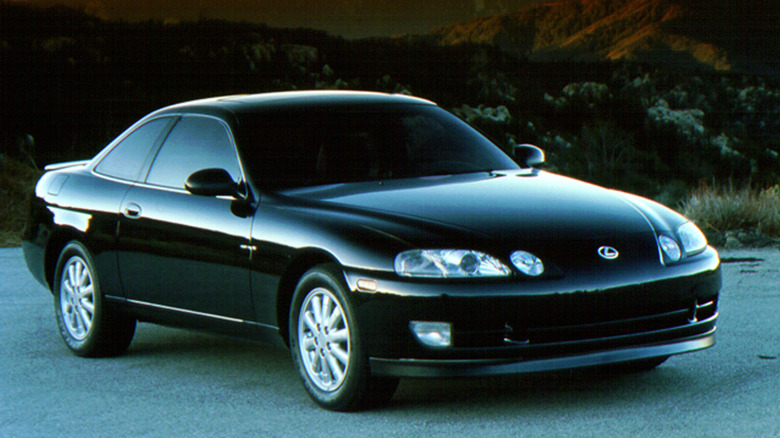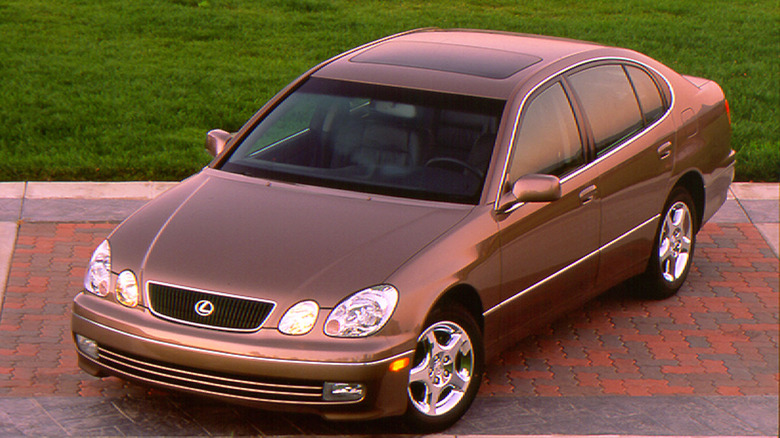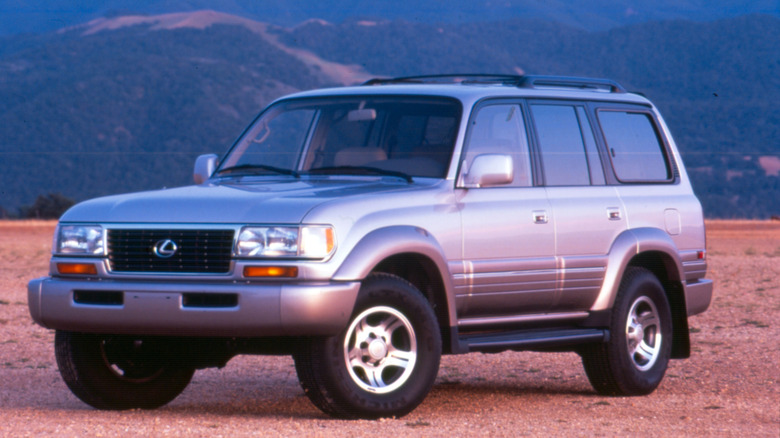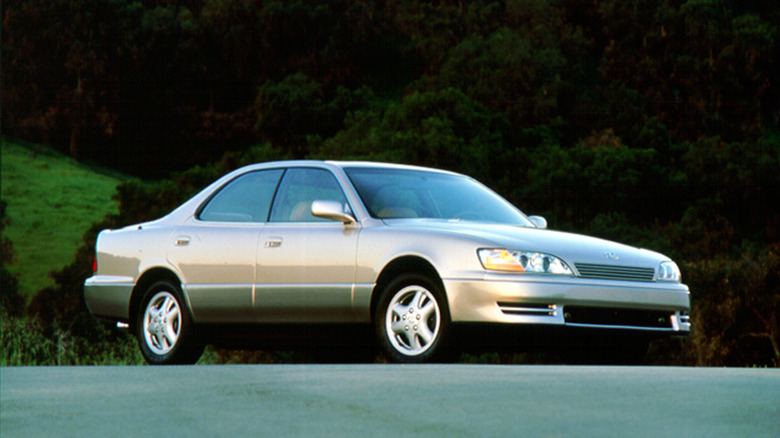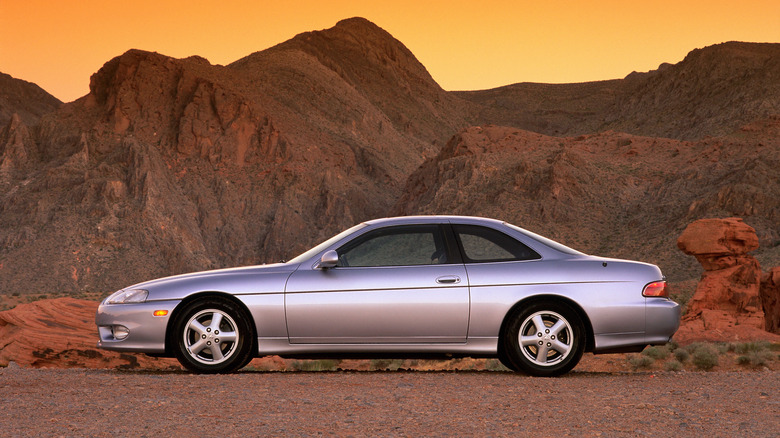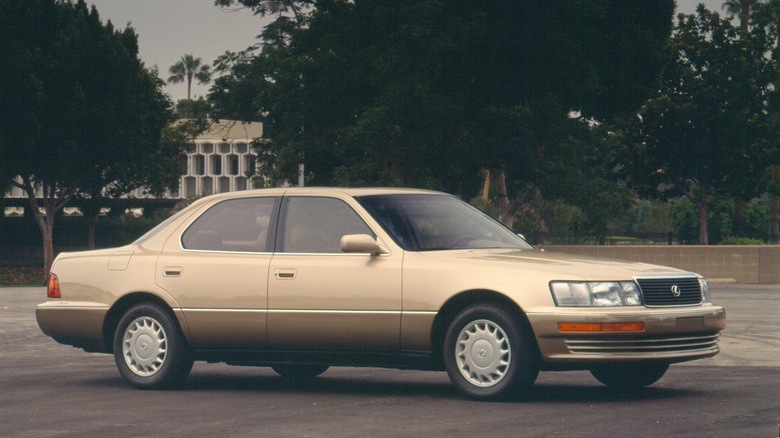5 Of The Best Lexus Models Of The 1990s
Despite being such a ubiquitous name to associate with mid-market luxury today, Lexus first opened its doors in just 1989. And right from the get-go, people questioned the viability of such a company -– after all, what hope would this Japanese off-shoot of Toyota have against the likes of BMW or Mercedes? Lexus had a lot to prove, and they had to prove themselves quickly to survive in the United States. How did they go about this task? Through over a billion dollars of research, customer service reaching absurd levels of excellence, and some absolutely fantastic cars.
You'll be hard-pressed to find any real "misses" among the many hits that Lexus made during the 1990s. This was prime-time Toyota, a decade still viewed fondly as one of unmatched reliability, engineering, and timeless design. Some of the company's finest automobiles left the factory in this decade, and the Lexus brand is no exception. Many of these vehicles share common traits with their Toyota cousins, whether it be powertrains and running gear to essentially being badge-engineered JDM Toyotas. In most cases, however, the Lexus models shine just as brightly, no matter what badging they feature. While there really aren't any stand-out "bad" models in this decade, there are quite a few which stand above the rest. Let's take a look at the six finest Lexus models of the 1990s and what made them so amazing.
Lexus GS (S160)
This sedan is the definition of a "sleeper," representing the closest thing the U.S. got to a high-spec JDM Toyota Chaser. Derived from the tenth-generation S150 Toyota Crown, the Lexus GS series exudes a certain understated opulence, continuing that classic Lexus tradition of refinement and propriety over brash design. However, that luxury exterior holds one of two outstanding powerplants: the 2JZ-GE or 1UZ-FE V8. Or, perhaps, a twin-turbo 2JZ-GTE if you find a JDM Toyota Aristo Turbo. This gave the GS a remarkable potential for going properly fast, a pure sleeper in the right hands. In fact, the platform even found its way into various motorsports over the years, such as drifting and touring car racing, looking gloriously out-of-place to boot.
Being a luxury car first and foremost, the GS excels at comfort and smoothness over outright performance. Much like how one would describe a Rolls-Royce as having "adequate" power, the base GS 300's 2JZ provides ample acceleration. But a straight-six is also an inherently exceptionally smooth-running engine, thanks to its perfect primary and secondary balance characteristics. Coupled with the optional 1UZ V8 powerplant, and the underpinnings of the GS alone are enough to carry this platform into the Lexus hall of fame. And that's not even mentioning all the interior options you get with this vehicle, though it wasn't as opulent as the LS flagship. Still, for a mid-size luxury car, it might not be as bold as something like a W124 Mercedes. But it's got an absolutely bulletproof engine and far more comfort than its initial price would indicate. In terms of bang for your buck, few classic Lexus models top the often-overlooked GS.
Lexus LX 450 (J80)
The name "Land Cruiser" has remained a byword for reliability for over 70 years now. What initially began as a Japanese take on an American military Jeep turned into arguably one of the finest SUVs ever produced, the J80-series. To make an LX, essentially all Lexus did was take a regular Land Cruiser, replace a few badges, and fit it with some luxury features. That's all there is to it: there's quite literally almost no difference between a Lexus LX 450 and a fully equipped Toyota. That said, they still (briefly) sold like hotcakes, with 14,584 units sold between 1996 and 1997. Because the original LX only sold for these two model years, this makes the LX 450 among the rarest regular-production Lexus vehicles that's not something like an LFA.
Why was it so great, though? For one, you'd be hard-pressed to find any glaring issues with either the running gear or powertrain. There's a good reason why these classic Toyotas found their ways to some of the most remote regions on Earth, after all. The only difference between them and the Lexus is that, in the LX, you'll just be doing it in a little more comfort, that's all. And sure, the LX 450 isn't exactly fast, nor is it a "sleeper" like the GS –- classic Land Cruisers of all shapes and sizes are highly prized vehicles. But it is extremely functional. In fact, the LX is possibly the most function-oriented Lexus model ever produced. Even looking at it, this car doesn't look like a typical Lexus. It looks like any other classic Land Cruiser, with few frills and a utilitarian aesthetic. Only the second-gen LX comes close, and that look is something that many people find appealing in classic SUVs.
Lexus ES 300 (XV10)
Ostensibly a luxury Toyota Camry, the Lexus ES 300 represents the "entry-level" Lexus model. Originally, the ES was a boxy, rushed design, intended to provide customers with more choice than just the one LS model when Lexus debuted as a company. In that sense, much like the Land Cruiser-based LX, the ES is badge-engineering in the truest sense of the word; this is little more than a rebadged early-90s Camry with luxury features. Although that seems bad at first glance, consider the original Camry's platform. This is a car which, like the Corolla and Tercel, effectively solidified into popular consciousness the sheer perennial reliability of the 1990s Toyota.
Very few vehicles of this era still run faultlessly more often than not, with these cars now hitting their 30s. Parts wear out on these old cars. But these Toyota V6 engines just keep going. Couple that with the traditional Lexus appointments, and you have what represents the quintessential budget-luxury experience of the 1990s, replete with a six-disc CD changer, leather seats, and hard plastic dashboard with lacquered wood inserts.
Because these cars were never fitted with the big-name Toyota engines known for the power numbers, they often get overlooked for other more popular offerings of the era. But the classic optional 1MZ-FE V6 still provides a good amount of reliability and overbuilt design, much like any other Toyota of its day. The transverse V6 is a pain to service in the car, sure. But with proper maintenance, these old V6s, especially the 1MZ, will give even a 1UZ a run for its money in terms of reliability, routinely cracking the hundreds of thousands of miles.
Lexus SC 300 (Z30)
First produced for the 1991 model year, the original Z30 Lexus SC 300 (the third-gen Toyota Soarer in Japan) is, almost without argument, the single best-looking Lexus in the company's first 20 years of existence. The lines of this car are simply exquisite, harkening back to the effortlessly timeless grand-tourer silhouette of the likes of the 2000GT. Couple that with the (naturally aspirated) 2JZ or 1UZ under the hood in the SC 400, and this vehicle represents one of the ultimate 90s sports-coupes for the price. Granted, it's still just naturally aspirated. But everyone knows what this engine's really capable of. Back in the 1990s, even Japanese police forces utilized the JDM Soarer in unmarked liveries to catch highway street racers.
In other words, the Lexus SC 300 is what results when you take a Supra SZ powertrain and fit it to a body meant to compete with the likes of Maserati or Cadillac. It sure doesn't look like a Supra, with a far more understated appearance overall (which some people may prefer). But thanks to those underpinnings, it's just as utterly dependable and easily tuned as any other similarly equipped Toyota of the era, with an absolutely gorgeous body to match. In a phrase, the original Lexus SC has its cake and eats it, too. The performance pedigree, reliability, luxury features, and timeless shape ensures that the original SC and its JDM counterpart continue bearing fruit, with the platform serving with distinction in such disciplines as top-level drifting and time attack to this day. Very few cars are that versatile to begin with, let alone still that good some 30-plus years later.
Lexus LS 400 (XF10)
Of course, what other Lexus could possibly top this list than the one which started it all, the LS 400. In its day, this car practically defined the phrase "excellence." It's difficult to understate the sheer impact of this vehicle when it debuted. Back then, most comparable vehicles in this segment commanded prices north of $50,000, with BMW and Mercedes dominating sales. Suddenly, in comes this random Japanese offshoot from a company best known for cheap economy cars. And what happens? Their vehicle outperforms its similarly equipped German competition in nearly every aspect, and they do it for less than $40,000. Essentially, this car was so good that it nearly killed BMW and Mercedes in America in just a couple of short years.
Even today, the LS 400 continues to impress despite its age. Unlike an E34 or a W124 Mercedes, these machines don't appear particularly dated thanks to the smooth, clean profile. The LS only ever featured one engine, the 4.0L 1UZ V8. But it never really needed much else, considering this engine's longevity is nothing short of legendary. Plus, it's not like a supple, comfortable leather interior ever goes out of style, and the LS has that in spades. Unlike bolder designs, this is a quintessentially Japanese luxury car, with a very tailored feel to it that goes out of its way to be smooth and understated, a point of pride for Lexus. But like a fine wine, its subtle notes give it an undeniably exquisite quality, with superb craftsmanship that easily stands the test of time. Not only was this the first bespoke Lexus model, this car also fundamentally rewrote the standard for mid-price luxury by which all other manufacturers have since followed, to varying levels of success.
